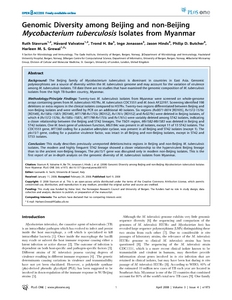Stavrum, R; Valvatne, H; Bø, TH; Jonassen, I; Hinds, J; Butcher, PD; Grewal, HM
(2008)
Genomic Diversity among Beijing and non-Beijing Mycobacterium tuberculosis Isolates from Myanmar.
PLOS ONE, 3 (4).
e1973 (1)- e1973 (11).
ISSN 1932-6203
https://doi.org/10.1371/journal.pone.0001973
SGUL Authors: Hinds, Jason
![[img]](https://openaccess.sgul.ac.uk/107064/1.hassmallThumbnailVersion/pone.0001973.pdf)  Preview |
|
["document_typename_application/pdf; charset=binary" not defined]
Published Version
Download (604kB)
| Preview
|
Abstract
Background: The Beijing family of Mycobacterium tuberculosis is dominant in countries in East Asia. Genomic
polymorphisms are a source of diversity within the M. tuberculosis genome and may account for the variation of virulence among M. tuberculosis isolates. Till date there are no studies that have examined the genomic composition of M. tuberculosis isolates from the high TB-burden country, Myanmar.
Methodology/Principle Findings: Twenty-two M. tuberculosis isolates from Myanmar were screened on whole-genome
arrays containing genes from M. tuberculosis H37Rv, M. tuberculosis CDC1551 and M. bovis AF22197. Screening identified 198 deletions or extra regions in the clinical isolates compared to H37Rv. Twenty-two regions differentiated between Beijing and non-Beijing isolates and were verified by PCR on an additional 40 isolates. Six regions (Rv0071-0074 [RD105], Rv1572-1576c [RD149], Rv1585c-1587c [RD149], MT1798-Rv1755c [RD152], Rv1761c [RD152] and Rv0279c) were deleted in Beijing isolates, of
which 4 (Rv1572-1576c, Rv1585c-1587c, MT1798-Rv1755c and Rv1761c) were variably deleted among ST42 isolates, indicating a closer relationship between the Beijing and ST42 lineages. The TbD1 region, Mb1582-Mb1583 was deleted in Beijing and ST42 isolates. One M. bovis gene of unknown function, Mb3184c was present in all isolates, except 11 of 13 ST42 isolates. The CDC1551 gene, MT1360 coding for a putative adenylate cyclase, was present in all Beijing and ST42 isolates (except 1). The pks15/1 gene, coding for a putative virulence factor, was intact in all Beijing and non-Beijing isolates, except in ST42 and ST53 isolates.
Conclusion: This study describes previously unreported deletions/extra regions in Beijing and non-Beijing M. tuberculosis isolates. The modern and highly frequent ST42 lineage showed a closer relationship to the hypervirulent Beijing lineage than to the ancient non-Beijing lineages. The pks15/1 gene was disrupted only in modern non-Beijing isolates. This is the first report of an in-depth analysis on the genomic diversity of M. tuberculosis isolates from Myanmar.
| Item Type: |
Article
|
| Additional Information: |
Copyright: 2008 Stavrum et al. This is an open-access article distributed under the terms of the Creative Commons Attribution License, which permits unrestricted use, distribution, and reproduction in any medium, provided the original author and source are credited. |
| Keywords: |
China, Gene Deletion, Genetic Variation, Genome, Bacterial, Myanmar, Mycobacterium tuberculosis, Nucleic Acid Hybridization, Oligonucleotide Array Sequence Analysis, Polymerase Chain Reaction, Polymorphism, Genetic, Sequence Analysis, DNA, Species Specificity, Tuberculosis, Multidrug-Resistant, Virulence, Science & Technology, Multidisciplinary Sciences, Science & Technology - Other Topics, General Science & Technology, MD Multidisciplinary |
| SGUL Research Institute / Research Centre: |
Academic Structure > Infection and Immunity Research Institute (INII) |
| Journal or Publication Title: |
PLOS ONE |
| ISSN: |
1932-6203 |
| Related URLs: |
|
| Web of Science ID: |
WOS:000260795500036 |
| Dates: |
| Date |
Event |
| 2008-04-09 |
Published |
|
| URI: |
https://openaccess.sgul.ac.uk/id/eprint/107064 |
| Publisher's version: |
https://doi.org/10.1371/journal.pone.0001973 |
Statistics
Item downloaded times since 17 Jul 2014.
Actions (login required)
 |
Edit Item |


